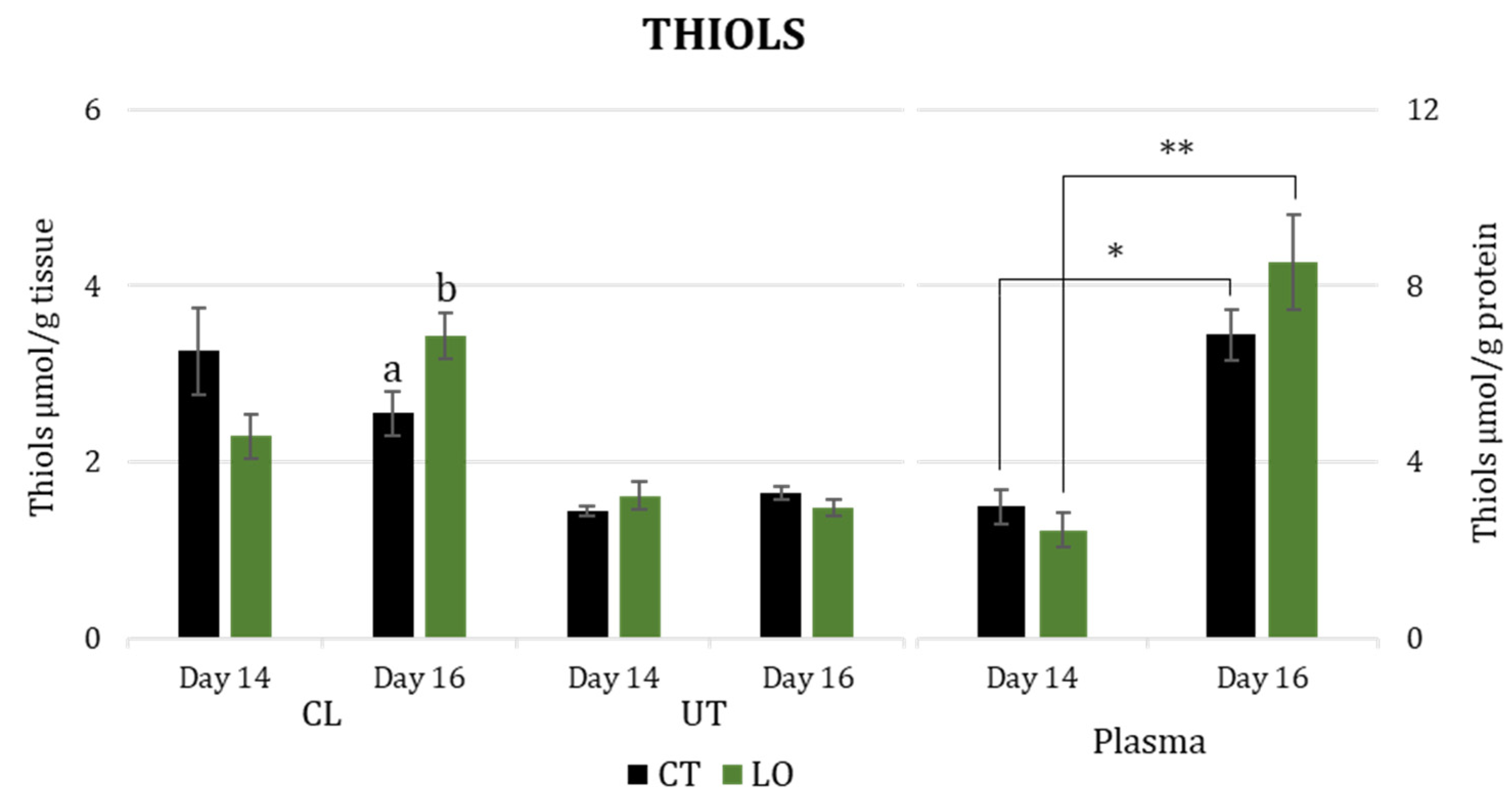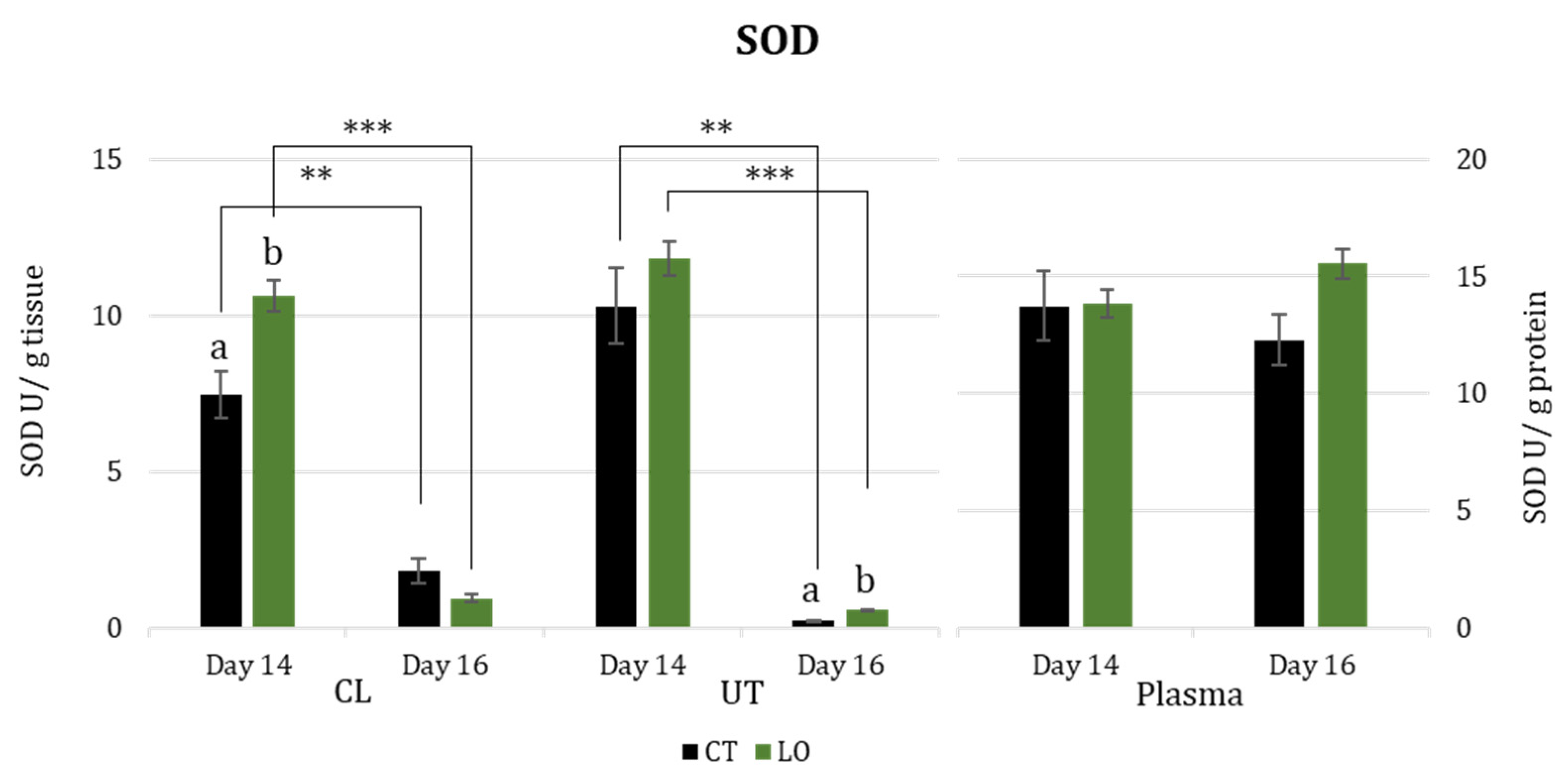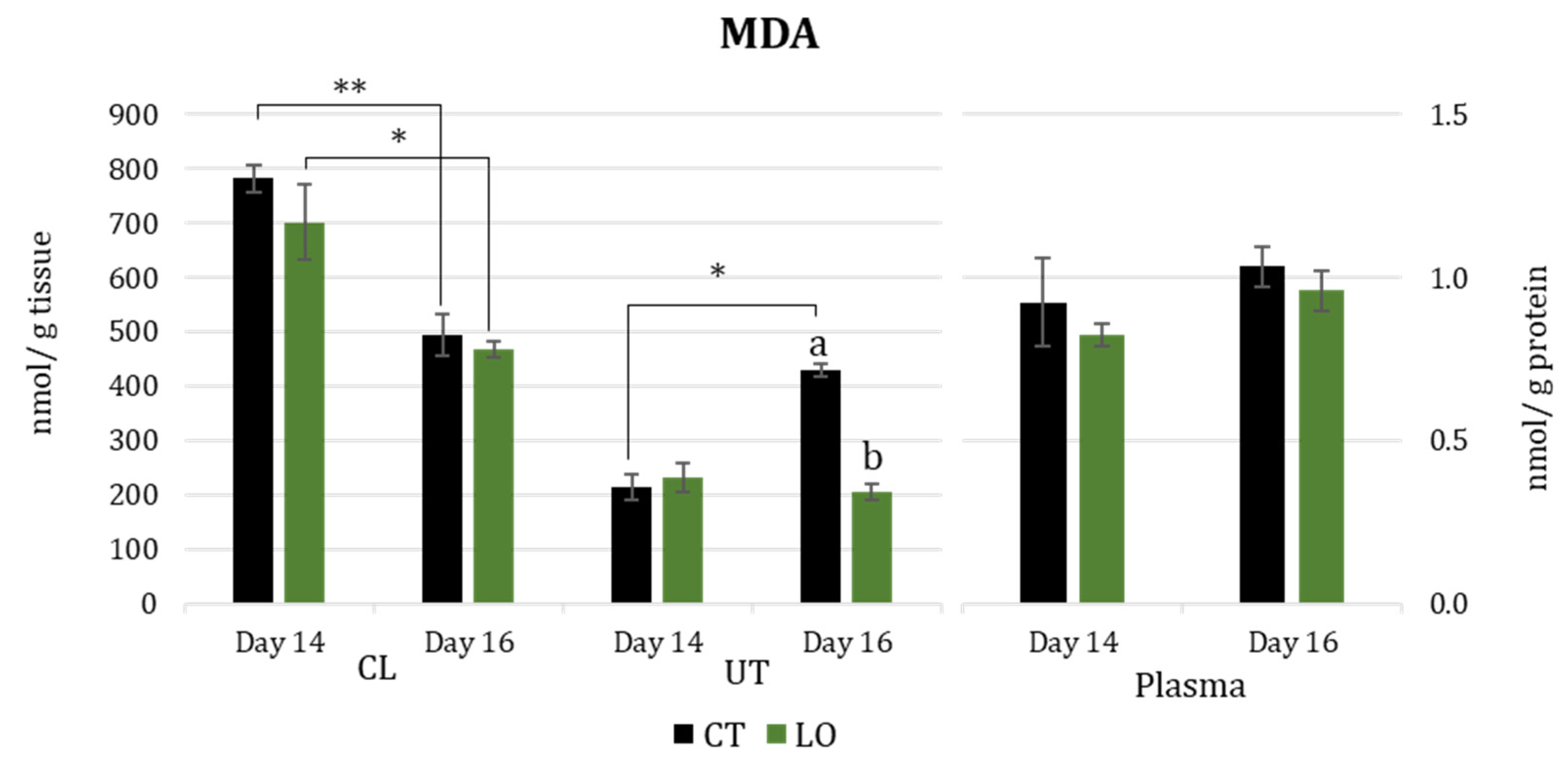The Effect of By-Pass Linseed Oil Supplementation on the Maternal Antioxidant System during the Embryo-Maternal Recognition Period in Ewes
Abstract
:Simple Summary
Abstract
1. Introduction
2. Materials and Methods
2.1. Animals and Treatment
2.2. Measurement and Sampling
2.2.1. Body Weight and Body Condition Score
2.2.2. Feedstuff Composition and Intake Measurement
2.2.3. Blood Sampling
2.2.4. Tissues Samples
2.3. Antioxidant Markers
2.3.1. Thiols Assay
2.3.2. Trolox Equivalent Antioxidant Capacity (TEAC) Assay
2.3.3. Superoxide Dismutase (SOD) Assay
2.3.4. Malondialdehyde (MDA) Assay
2.4. Protein Assay
2.5. Progesterone (P4) Measurement
2.6. Statistical Analyses
3. Results
4. Discussion
5. Conclusions
Author Contributions
Funding
Institutional Review Board Statement
Informed Consent Statement
Data Availability Statement
Acknowledgments
Conflicts of Interest
References
- Yang, L.; Yang, C.; Chu, C.; Wan, M.; Xu, D.; Pan, D.; Xia, H.; Wang, S.K.; Shu, G.; Chen, S.; et al. Beneficial Effects of Monounsaturated Fatty Acid-Rich Blended Oils with an Appropriate Polyunsaturated/Saturated Fatty Acid Ratio and a Low n-6/n-3 Fatty Acid Ratio on the Health of Rats. J. Sci. Food Agric. 2022, 102, 7172–7185. [Google Scholar] [CrossRef]
- Tsoupras, A.; Brummell, C.; Kealy, C.; Vitkaitis, K.; Redfern, S.; Zabetakis, I. Cardio-Protective Properties and Health Benefits of Fish Lipid Bioactives; The Effects of Thermal Processing. Mar. Drugs 2022, 20, 187. [Google Scholar] [CrossRef]
- Hooper, L. Lipid Biochemistry. J. Hum. Nutr. Diet. 2002, 15, 469. [Google Scholar] [CrossRef]
- Wathes, D.C.; Abayasekara, D.R.E.; Aitken, R.J. Polyunsaturated Fatty Acids in Male and Female Reproduction. Biol. Reprod. 2007, 77, 190–201. [Google Scholar] [CrossRef] [PubMed]
- Kaur, N.; Chugh, V.; Gupta, A.K. Essential Fatty Acids as Functional Components of Foods—A Review. J. Food Sci. Technol. 2014, 51, 2289–2303. [Google Scholar] [CrossRef] [Green Version]
- Gulliver, C.E.; Friend, M.A.; King, B.J.; Clayton, E.H. The Role of Omega-3 Polyunsaturated Fatty Acids in Reproduction of Sheep and Cattle. Anim. Reprod. Sci. 2012, 131, 9–22. [Google Scholar] [CrossRef]
- Moallem, U. Invited Review: Roles of Dietary n-3 Fatty Acids in Performance, Milk Fat Composition, and Reproductive and Immune Systems in Dairy Cattle. J. Dairy Sci. 2018, 101, 8641–8661. [Google Scholar] [CrossRef] [Green Version]
- Kalač, P.; Samková, E. The Effects of Feeding Various Forages on Fatty Acid Composition of Bovine Milk Fat: A Review. Czech J. Anim. Sci. 2010, 55, 521–537. [Google Scholar] [CrossRef] [Green Version]
- Jenkins, T.C.; Harvatine, K.J. Lipid Feeding and Milk Fat Depression. Vet. Clin. N. Am. Food Anim. Pract. 2014, 30, 623–642. [Google Scholar] [CrossRef] [PubMed]
- El-Tarabany, M.S.; Atta, M.A.; Emara, S.S.; Mostafa, M.M. Folic Acid and Flaxseed Oil Supplements in Ossimi Ewes: Effect on Body Weight Changes, Progesterone Profile, Blood Chemistry, and Litter Traits. Trop. Anim. Health Prod. 2020, 52, 301–308. [Google Scholar] [CrossRef] [PubMed]
- Jenkins, T.C.; Bridges, W.C. Protection of Fatty Acids against Ruminal Biohydrogenation in Cattle. Eur. J. Lipid Sci. Technol. 2007, 109, 778–789. [Google Scholar] [CrossRef]
- Dirandeh, E.; Towhidi, A.; Ansari Pirsaraei, Z.; Saberifar, T.; Akhlaghi, A.; Rezaei Roodbari, A. The Endometrial Expression of Prostaglandin Cascade Components in Lactating Dairy Cows Fed Different Polyunsaturated Fatty Acids. Theriogenology 2015, 83, 206–212. [Google Scholar] [CrossRef] [PubMed]
- Heshmati, J.; Morvaridzadeh, M.; Maroufizadeh, S.; Akbari, A.; Yavari, M.; Amirinejad, A.; Maleki-Hajiagha, A.; Sepidarkish, M. Omega-3 Fatty Acids Supplementation and Oxidative Stress Parameters: A Systematic Review and Meta-Analysis of Clinical Trials. Pharmacol. Res. 2019, 149, 104462. [Google Scholar] [CrossRef]
- Didara, M.; Poljičak-Milas, N.; Milinković-Tur, S.; Mašek, T.; Šuran, J.; Pavić, M.; Kardum, M.; Šperanda, M. Immune and Oxidative Response to Linseed in the Diet of Periparturient Holstein Cows. Animal 2015, 9, 1349–1354. [Google Scholar] [CrossRef] [Green Version]
- Li, W.H.; Weng, X.X.; Yuan, L.F.; Li, F.; Yue, X.P.; Li, F.D. Effect of Feeding Linseed Diet on Testis Development, Antioxidant Capacity, and Epididymal Cauda Sperm Concentration in Chinese Hu Lamb. Theriogenology 2021, 159, 69–76. [Google Scholar] [CrossRef]
- Rizzo, A.; Roscino, M.T.; Binetti, F.; Sciorsci, R.L. Roles of Reactive Oxygen Species in Female Reproduction. Reprod. Domest. Anim. 2012, 47, 344–352. [Google Scholar] [CrossRef]
- Contreras-Solís, I.; Porcu, C.; Sotgiu, F.D.; Chessa, F.; Pasciu, V.; Dattena, M.; Caredda, M.; Abecia, J.A.; Molle, G.; Berlinguer, F. Effect of Strategic Supplementation of Dietary By-Pass Linseed Oil on Fertility and Milk Quality in Sarda Ewes. Animals 2023, 13, 280. [Google Scholar] [CrossRef]
- Russel, A.; Doney, J.; Gunn, R. Subjective Assessment of Body Fat in Live Sheep. J. Agric. Sci. 1969, 72, 451–454. [Google Scholar] [CrossRef]
- Petit, H.V.; Germiquet, C.; Lebel, D. Effect of Feeding Whole, Unprocessed Sunflower Seeds and Flaxseed on Milk Production, Milk Composition, and Prostaglandin Secretion in Dairy Cows. J. Dairy Sci. 2004, 87, 3889–3898. [Google Scholar] [CrossRef] [PubMed] [Green Version]
- Griffiths, H.R.; Møller, L.; Bartosz, G.; Bast, A.; Bertoni-Freddari, C.; Collins, A.; Cooke, M.; Coolen, S.; Haenen, G.; Hoberg, A.M.; et al. Biomarkers. Mol. Asp. Med. 2002, 23, 101–208. [Google Scholar] [CrossRef] [PubMed]
- Re, R.; Pellegrini, N.; Proteggente, A.; Pannala, A.; Yang, M.; Rice-Evans, C. Antioxidant Activity Applying an Improved ABTS Radical Cation Decolorization Assay. Free Radic. Biol. Med. 1999, 26, 1231–1237. [Google Scholar] [CrossRef] [PubMed]
- Lewinska, A.; Wnuk, M.; Slota, E.; Bartosz, G. Total Anti-Oxidant Capacity of Cell Culture Media. Clin. Exp. Pharmacol. Physiol. 2007, 34, 781–786. [Google Scholar] [CrossRef]
- Ukeda, H.; Maeda, S.; Ishii, T.; Sawamura, M. Spectrophotometric Assay for Superoxide Dismutase Based on Tetrazolium Salt 3’-{1-[(Phenylamino)-Carbonyl]-3,4-Tetrazolium}-Bis(4-Methoxy-6-Nitro)Benzenesulfonic Acid Hydrate Reduction by Xanthine-Xanthine Oxidase. Anal. Biochem. 1997, 251, 206–209. [Google Scholar] [CrossRef] [PubMed]
- Spanier, A.; Traylor, R. A Rapid, Direct Chemical Assay for the Quantitative Determination of Thiobarbituric Acid Reactive Substances in Raw, Cooked, and Cooked/Stored Muscle Foods. J. Muscle Foods 2007, 2, 165–176. [Google Scholar] [CrossRef]
- Varoni, M.V.; Gadau, S.D.; Pasciu, V.; Baralla, E.; Serra, E.; Palomba, D.; Demontis, M.P. Investigation of the Effects of Lycium Barbarum Polysaccharides against Cadmium Induced Damage in Testis. Exp. Mol. Pathol. 2017, 103, 26–32. [Google Scholar] [CrossRef]
- Berlinguer, F.; Pasciu, V.; Succu, S.; Cossu, I.; Caggiu, S.; Addis, D.; Castagna, A.; Fontani, V.; Rinaldi, S.; Passino, E.S. REAC Technology as Optimizer of Stallion Spermatozoa Liquid Storage. Reprod. Biol. Endocrinol. 2017, 15, 11. [Google Scholar] [CrossRef] [Green Version]
- Lowry, O.H.; Rosebrough, N.J.; Farr, A.L.; Randall, R.J. Protein Measurement with the Folin Phenol Reagent. J. Biol. Chem. 1951, 193, 265–275. [Google Scholar] [CrossRef]
- Pasciu, V.; Nieddu, M.; Baralla, E.; Porcu, C.; Sotgiu, F.; Berlinguer, F. Measurement of Progesterone in Sheep Using a Commercial ELISA Kit for Human Plasma. J. Vet. Diagn. Investig. 2022, 34, 90–93. [Google Scholar] [CrossRef]
- Petit, H.V.; Dewhurst, R.J.; Scollan, N.D.; Proulx, J.G.; Khalid, M.; Haresign, W.; Twagiramungu, H.; Mann, G.E. Milk Production and Composition, Ovarian Function, and Prostaglandin Secretion of Dairy Cows Fed Omega-3 Fats. J. Dairy Sci. 2002, 85, 889–899. [Google Scholar] [CrossRef]
- Oppedisano, F.; Macrì, R.; Gliozzi, M.; Musolino, V.; Carresi, C.; Maiuolo, J.; Bosco, F.; Nucera, S.; Zito, M.C.; Guarnieri, L.; et al. The Anti-Inflammatory and Antioxidant Properties of n-3 PUFAs: Their Role in Cardiovascular Protection. Biomedicines 2020, 8, 306. [Google Scholar] [CrossRef]
- Baba, S.P.; Bhatnagar, A. Role of Thiols in Oxidative Stress. Curr. Opin. Toxicol. 2018, 7, 133–139. [Google Scholar] [CrossRef]
- Agarwal, A.; Gupta, S.; Sharma, R.K. Role of Oxidative Stress in Female Reproduction. Reprod. Biol. Endocrinol. 2005, 3, 28. [Google Scholar] [CrossRef] [Green Version]
- Schmitz, G.; Ecker, J. The Opposing Effects of n-3 and n-6 Fatty Acids. Prog. Lipid Res. 2008, 47, 147–155. [Google Scholar] [CrossRef]
- Mittal, M.; Siddiqui, M.R.; Tran, K.; Reddy, S.P.; Malik, A.B. Reactive Oxygen Species in Inflammation and Tissue Injury. Antioxid. Redox Signal. 2014, 20, 1126–1167. [Google Scholar] [CrossRef] [PubMed] [Green Version]
- Mavangira, V.; Sordillo, L.M. Role of Lipid Mediators in the Regulation of Oxidative Stress and Inflammatory Responses in Dairy Cattle. Res. Vet. Sci. 2018, 116, 4–14. [Google Scholar] [CrossRef] [PubMed]
- Ulrich, K.; Ursula, J. The Role of Thiols in Antioxidant Systems. Free Radic. Biol. Med. 2016, 176, 139–148. [Google Scholar] [CrossRef] [PubMed]
- Al-Gubory, K.H.; Bolifraud, P.; Germain, G.; Nicole, A.; Ceballos-Bicot, I. Antioxidant Enzymatic Defence Systems in Sheep Corpus Luteum throughout Pregnancy. Reproduction 2004, 128, 767–774. [Google Scholar] [CrossRef] [Green Version]
- Bergsma, A.T.; Li, H.T.; Eliveld, J.; Bulthuis, M.L.C.; Hoek, A.; van Goor, H.; Bourgonje, A.R.; Cantineau, A.E.P. Local and Systemic Oxidative Stress Biomarkers for Male Infertility: The ORION Study. Antioxidants 2022, 11, 1045. [Google Scholar] [CrossRef]
- Al-Gubory, K.H.; Garrel, C.; Faure, P.; Sugino, N. Roles of Antioxidant Enzymes in Corpus Luteum Rescue from Reactive Oxygen Species-Induced Oxidative Stress. Reprod. Biomed. Online 2012, 25, 551–560. [Google Scholar] [CrossRef] [Green Version]
- Celi, P. Biomarkers of Oxidative Stress in Ruminant Medicine. Immunopharmacol. Immunotoxicol. 2011, 33, 233–240. [Google Scholar] [CrossRef]
- Ramos, R.S.; Oliveira, M.L.; Izaguirry, A.P.; Vargas, L.M.; Soares, M.B.; Mesquita, F.S.; Santos, F.W.; Binelli, M. The Periovulatory Endocrine Milieu Affects the Uterine Redox Environment in Beef Cows. Reprod. Biol. Endocrinol. 2015, 13, 39. [Google Scholar] [CrossRef] [PubMed] [Green Version]
- Varoni, M.V.; Pasciu, V.; Gadau, S.D.; Baralla, E.; Serra, E.; Palomba, D.; Demontis, M.P. Possible Antioxidant Effect of Lycium Barbarum Polysaccharides on Hepatic Cadmium-Induced Oxidative Stress in Rats. Environ. Sci. Pollut. Res. 2017, 24, 2946–2955. [Google Scholar] [CrossRef]
- Fedotcheva, T.A.; Kruglov, A.G.; Teplova, V.V.; Fedotcheva, N.I.; Rzheznikov, V.M.; Shimanovskii, N.L. Effect of Steroid Hormones on Production of Reactive Oxygen Species in Mitochondria. Biophysics 2012, 57, 792–795. [Google Scholar] [CrossRef]
- Chainy, G.B.N.; Sahoo, D.K. Hormones and Oxidative Stress: An Overview. Free Radic. Res. 2020, 54, 1–26. [Google Scholar] [CrossRef] [PubMed]





| p Value | |||||
|---|---|---|---|---|---|
| Variables | Group | Mean ± S.E.M. | Group | Time | Group × Time |
| BW (Kg) | CT | 38.82 ± 0.64 | n.s. | *** | n.s. |
| LO | 39.08 ± 0.55 | ||||
| BCS a | CT | 2.48 ± 0.03 | n.s. | n.s. | n.s. |
| LO | 2.55 ± 0.03 | ||||
| Total NE Intake (Mcal/ewe/day) | CT | 1.47 ± 0.01 | n.s. | n.s. | n.s. |
| LO | 1.47 ± 0.01 |
| Thiols-CL | Thiols-UT | Thiols-PLASMA | TEAC-CL | TEAC-UT | TEAC-PLASMA | SOD-CL | SOD-UT | SOD-PLASMA | MDA-CL | MDA-UT | MDA-PLASMA | |
|---|---|---|---|---|---|---|---|---|---|---|---|---|
| Thiols-UT | −0.452 (0.261) | |||||||||||
| Thiols-PLASMA | −0.119 * (0.779) | −0.048 * (0.911) | ||||||||||
| TEAC-CL | 0.938 (0.001) | −0.486 (0.222) | 0.119 * (0.779) | |||||||||
| TEAC-UT | −0.532 (0.175) | 0.476 (0.233) | −0.357 * (0.385) | −0.416 (0.305) | ||||||||
| TEAC-PLASMA | 0.144 (0.734) | 0.562 (0.147) | −0.452 * (0.260) | 0.026 (0.951) | 0.448 (0.266) | |||||||
| SOD-CL | −0.869 (0.005) | 0.489 (0.219) | −0.333 * (0.420) | −0.820 (0.013) | 0.657 (0.077) | 0.039 (0.927) | ||||||
| SOD-UT | −0.280 (0.502) | −0.258 (0.537) | −0.238 * (0.570) | −0.23 (0.584) | 0.063 (0.883) | −0.323 (0.436) | 0.556 (0.152) | |||||
| SOD-PLASMA | 0.489 (0.219) | −0.011 (0.980) | −0.548 * (0.160) | 0.509 (0.198) | −0.093 (0.827) | 0.024 (0.956) | −0.240 (0.567) | 0.116 (0.784) | ||||
| MDA-CL | 0.177 (0.675) | −0.531 (0.176) | 0.548 * (0.160) | 0.274 (0.511) | −0.135 (0.75) | −0.394 (0.334) | −0.367 (0.372) | −0.325 (0.433) | −0.454 (0.259) | |||
| MDA-UT | −0.225 (0.591) | 0.552 (0.156) | 0.286 * (0.493) | −0.268 (0.52) | 0.414 (0.308) | 0.359 (0.382) | 0.204 (0.628) | −0.525 (0.182) | −0.363 (0.376) | 0.331 (0.423) | ||
| MDA-PLASMA | −0.512 (0.195) | −0.166 (0.694) | 0.429 * (0.289) | −0.484 (0.225) | −0.268 (0.522) | −0.522 (0.185) | 0.208 (0.621) | 0.121 (0.775) | −0.816 (0.013) | 0.390 (0.340) | 0.020 (0.962) | |
| P4-DAY 14 | −0.199 (0.636) | −0.196 (0.642) | 0.381 * (0.352) | −0.338 (0.414) | −0.675 (0.067) | −0.513 (0.193) | −0.036 (0.932) | 0.208 (0.621) | −0.214 (0.611) | −0.185 (0.660) | −0.451 (0.262) | 0.605 (0.112) |
| Thiols-CL | Thiols-UT | Thiols-PLASMA | TEAC-CL | TEAC-UT | TEAC-PLASMA | SOD-CL | SOD-UT | SOD-PLASMA | MDA-CL | MDA-UT | MDA-PLASMA | |
|---|---|---|---|---|---|---|---|---|---|---|---|---|
| Thiols-UT | −0.452 (0.261) | |||||||||||
| Thiols-PLASMA | 0.413 (0.309) | 0.350 (0.396) | ||||||||||
| TEAC-CL | 0.796 (0.018) | −0.344 (0.405) | 0.474 (0.235) | |||||||||
| TEAC-UT | 0.498 (0.210) | −0.414 (0.308) | 0.487 (0.220) | 0.816 (0.014) | ||||||||
| TEAC-PLASMA | −0.716 (0.046) | 0.408 (0.315) | −0.066 (0.877) | −0.449 (0.265) | −0.132 (0.756) | |||||||
| SOD-CL | −0.543 (0.164) | 0.022 (0.959) | −0.676 (0.066) | −0.617 (0.103) | −0.466 (0.244) | 0.555 (0.153) | ||||||
| SOD-UT | 0.745 (0.034) | −0.575 (0.136) | 0.379 (0.354) | 0.877 (0.004) | 0.797 (0.018) | −0.599 (0.117) | −0.692 (0.057) | |||||
| SOD-PLASMA | 0.495 (0.212) | −0.018 (0.967) | 0.752 (0.031) | 0.698 (0.054) | 0.605 (0.112) | −0.113 (0.789) | −0.776 (0.024) | 0.676 (0.065) | ||||
| MDA-CL | 0.183 (0.665) | −0.448 (0.266) | −0.586 (0.127) | −0.232 (0.580) | −0.463 (0.248) | −0.672 (0.068) | 0.107 (0.801) | 0.022 (0.959) | −0.487 (0.220) | |||
| MDA-UT | −0.694 (0.056) | 0.492 (0.215) | −0.546 (0.162) | −0.874 (0.005) | −0.910 (0.002) | 0.334 (0.418) | 0.610 (0.108) | −0.935 (0.001) | −0.769 (0.026) | 0.268 (0.520) | ||
| MDA-PLASMA | −0.172 (0.683) | 0.570 (0.140) | 0.005 (0.991) | −0.065 (0.879) | −0.159 (0.708) | 0.357 (0.385) | 0.503 (0.204) | −0.441 (0.274) | −0.336 (0.416) | −0.329 (0.426) | 0.332 (0.421) | |
| P4-DAY 16 | −0.466 (0.351) | 0.270 (0.605) | 0.650 (0.162) | 0.066 (0.901) | 0.237 (0.651) | 0.165 (0.754) | −0.879 (0.021) | 0.176 (0.739) | 0.631 (0.179) | −0.628 (0.181) | −0.188 (0.721) | −0.766 (0.076) |
Disclaimer/Publisher’s Note: The statements, opinions and data contained in all publications are solely those of the individual author(s) and contributor(s) and not of MDPI and/or the editor(s). MDPI and/or the editor(s) disclaim responsibility for any injury to people or property resulting from any ideas, methods, instructions or products referred to in the content. |
© 2023 by the authors. Licensee MDPI, Basel, Switzerland. This article is an open access article distributed under the terms and conditions of the Creative Commons Attribution (CC BY) license (https://creativecommons.org/licenses/by/4.0/).
Share and Cite
Contreras-Solís, I.; Pasciu, V.; Porcu, C.; Sotgiu, F.D.; Todorova, N.; Baralla, E.; Mara, L.; Gallus, M.; Cabiddu, A.; Dattena, M.; et al. The Effect of By-Pass Linseed Oil Supplementation on the Maternal Antioxidant System during the Embryo-Maternal Recognition Period in Ewes. Animals 2023, 13, 2565. https://doi.org/10.3390/ani13162565
Contreras-Solís I, Pasciu V, Porcu C, Sotgiu FD, Todorova N, Baralla E, Mara L, Gallus M, Cabiddu A, Dattena M, et al. The Effect of By-Pass Linseed Oil Supplementation on the Maternal Antioxidant System during the Embryo-Maternal Recognition Period in Ewes. Animals. 2023; 13(16):2565. https://doi.org/10.3390/ani13162565
Chicago/Turabian StyleContreras-Solís, Ignacio, Valeria Pasciu, Cristian Porcu, Francesca D. Sotgiu, Neda Todorova, Elena Baralla, Laura Mara, Marilia Gallus, Andrea Cabiddu, Maria Dattena, and et al. 2023. "The Effect of By-Pass Linseed Oil Supplementation on the Maternal Antioxidant System during the Embryo-Maternal Recognition Period in Ewes" Animals 13, no. 16: 2565. https://doi.org/10.3390/ani13162565






